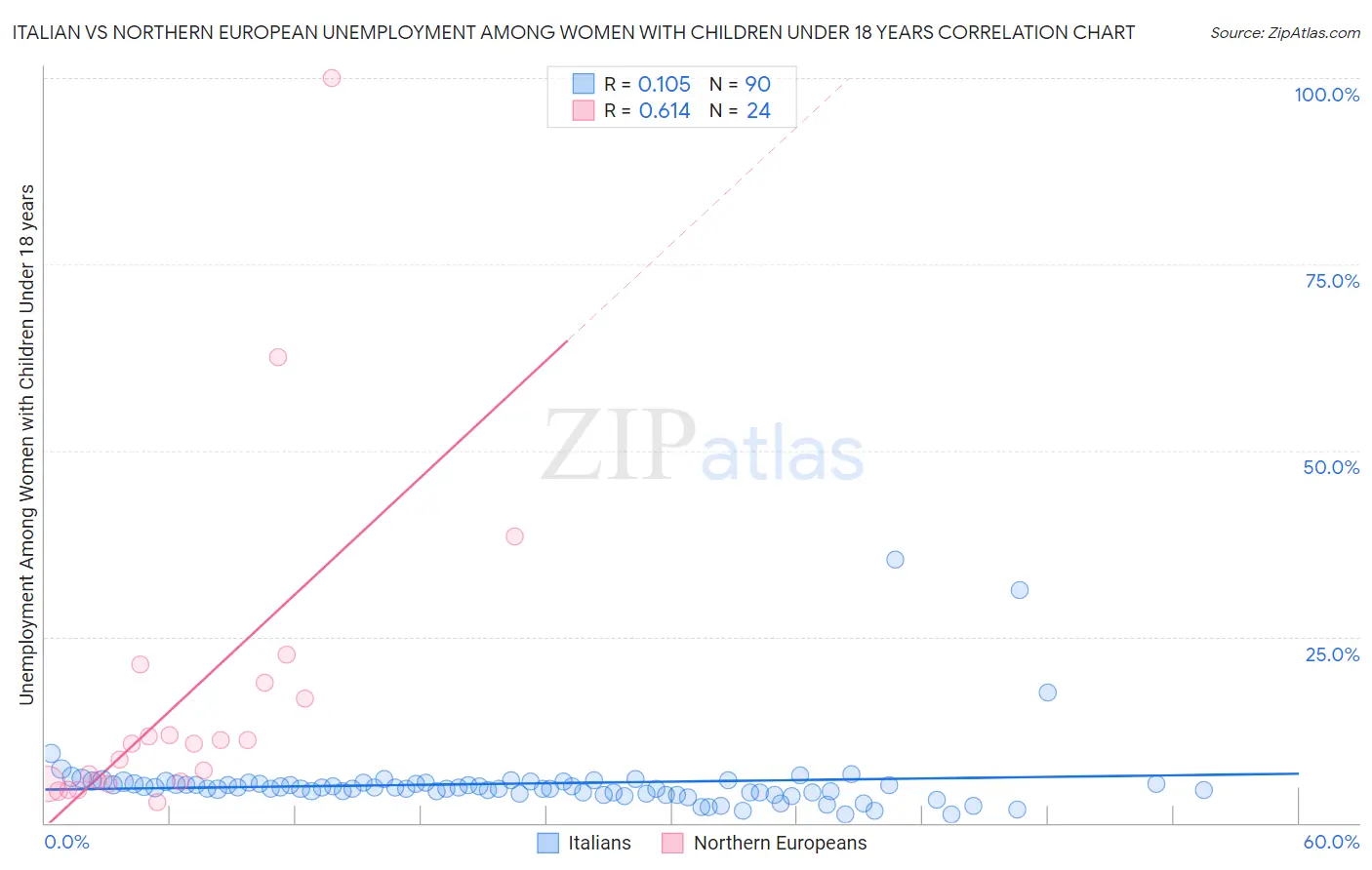Italian vs Northern European Unemployment Among Women with Children Under 18 years
COMPARE
Italian
Northern European
Unemployment Among Women with Children Under 18 years
Unemployment Among Women with Children Under 18 years Comparison
Italians
Northern Europeans
5.1%
UNEMPLOYMENT AMONG WOMEN WITH CHILDREN UNDER 18 YEARS
97.4/ 100
METRIC RATING
63rd/ 347
METRIC RANK
5.0%
UNEMPLOYMENT AMONG WOMEN WITH CHILDREN UNDER 18 YEARS
98.6/ 100
METRIC RATING
48th/ 347
METRIC RANK
Italian vs Northern European Unemployment Among Women with Children Under 18 years Correlation Chart
The statistical analysis conducted on geographies consisting of 518,789,873 people shows a poor positive correlation between the proportion of Italians and unemployment rate among women with children under the age of 18 in the United States with a correlation coefficient (R) of 0.105 and weighted average of 5.1%. Similarly, the statistical analysis conducted on geographies consisting of 384,114,804 people shows a significant positive correlation between the proportion of Northern Europeans and unemployment rate among women with children under the age of 18 in the United States with a correlation coefficient (R) of 0.614 and weighted average of 5.0%, a difference of 1.2%.

Unemployment Among Women with Children Under 18 years Correlation Summary
| Measurement | Italian | Northern European |
| Minimum | 1.1% | 2.7% |
| Maximum | 35.4% | 100.0% |
| Range | 34.3% | 97.3% |
| Mean | 5.3% | 17.0% |
| Median | 4.7% | 10.7% |
| Interquartile 25% (IQ1) | 4.1% | 5.4% |
| Interquartile 75% (IQ3) | 5.4% | 17.7% |
| Interquartile Range (IQR) | 1.3% | 12.3% |
| Standard Deviation (Sample) | 4.7% | 22.0% |
| Standard Deviation (Population) | 4.6% | 21.6% |
Demographics Similar to Italians and Northern Europeans by Unemployment Among Women with Children Under 18 years
In terms of unemployment among women with children under 18 years, the demographic groups most similar to Italians are Immigrants from Bulgaria (5.1%, a difference of 0.010%), Russian (5.1%, a difference of 0.080%), Estonian (5.1%, a difference of 0.17%), Immigrants from Sweden (5.1%, a difference of 0.19%), and Welsh (5.1%, a difference of 0.23%). Similarly, the demographic groups most similar to Northern Europeans are British (5.0%, a difference of 0.13%), Lithuanian (5.0%, a difference of 0.22%), Immigrants from Korea (5.0%, a difference of 0.25%), Immigrants from Japan (5.0%, a difference of 0.25%), and Yugoslavian (5.1%, a difference of 0.33%).
| Demographics | Rating | Rank | Unemployment Among Women with Children Under 18 years |
| Immigrants | Malaysia | 98.8 /100 | #45 | Exceptional 5.0% |
| Immigrants | Korea | 98.7 /100 | #46 | Exceptional 5.0% |
| British | 98.7 /100 | #47 | Exceptional 5.0% |
| Northern Europeans | 98.6 /100 | #48 | Exceptional 5.0% |
| Lithuanians | 98.4 /100 | #49 | Exceptional 5.0% |
| Immigrants | Japan | 98.4 /100 | #50 | Exceptional 5.0% |
| Yugoslavians | 98.3 /100 | #51 | Exceptional 5.1% |
| Immigrants | Nepal | 98.3 /100 | #52 | Exceptional 5.1% |
| Scottish | 98.2 /100 | #53 | Exceptional 5.1% |
| Immigrants | Serbia | 98.2 /100 | #54 | Exceptional 5.1% |
| Immigrants | Sri Lanka | 98.1 /100 | #55 | Exceptional 5.1% |
| Immigrants | Ireland | 98.0 /100 | #56 | Exceptional 5.1% |
| Czechoslovakians | 98.0 /100 | #57 | Exceptional 5.1% |
| Immigrants | Belgium | 97.9 /100 | #58 | Exceptional 5.1% |
| Asians | 97.9 /100 | #59 | Exceptional 5.1% |
| Welsh | 97.7 /100 | #60 | Exceptional 5.1% |
| Russians | 97.5 /100 | #61 | Exceptional 5.1% |
| Immigrants | Bulgaria | 97.4 /100 | #62 | Exceptional 5.1% |
| Italians | 97.4 /100 | #63 | Exceptional 5.1% |
| Estonians | 97.2 /100 | #64 | Exceptional 5.1% |
| Immigrants | Sweden | 97.1 /100 | #65 | Exceptional 5.1% |